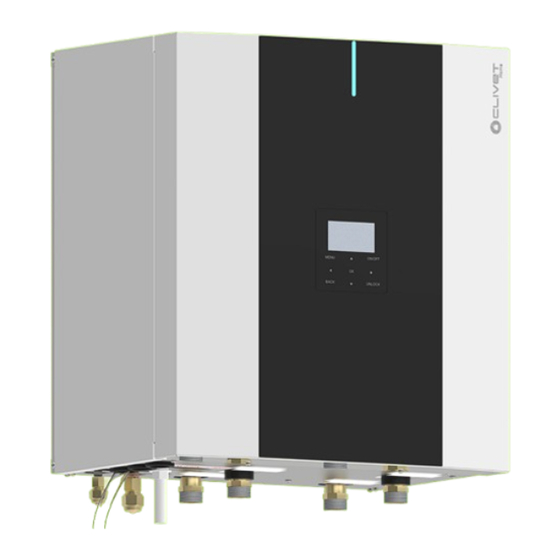
Table of Contents

Summarization of Contents
General Information
About the manual
Explains the manual's purpose, structure, and intended audience.
Symbols Used
Defines symbols used in the manual and on the unit for clarity and safety.
Recipients of Instructions
Defines intended users (User, Installer, Tech Support) and their responsibilities.
General Safety Warnings
Provides critical warnings for safe operations, handling, and general precautions.
About R-32 Refrigerant
Warnings for Installer and Technical Support
Specific safety warnings for professionals handling the refrigerant.
General Warnings
General safety advice concerning the flammable refrigerant.
Safety Checks and Procedures
Detailed checks and procedures for safe refrigerant handling and operations.
Electrical Device Checks
Safety checks for electrical components related to refrigerant.
Sealed and Intrinsically Safe Components
Guidelines for securing components and installing intrinsically safe ones.
Leak Detection Methods
Recommended methods and precautions for detecting refrigerant leaks.
Removal, Evacuation, and Charging
Procedures for safely removing, evacuating, and charging refrigerant.
Installation Requirements
Requirements for installing the unit safely and correctly.
Total Refrigerant Charge in System
Regulations regarding refrigerant charge and minimum room requirements.
Presentation of the Product
Identification and Serial Number Label
Details on the unit's serial number label and its information.
Regulatory Framework
Information on the relevant regulatory framework and conformity.
Intended Use and Description
Specifies the intended applications and brief description of the unit.
Combinations with Outdoor Units
Lists compatible outdoor units.
Main Components
Identifies and illustrates the main components of the unit.
Components Supplied with the Unit
Lists the items included in the product package.
Before Installation
Prerequisites
Essential requirements and safety checks before installation.
Reception and Inspection
Procedures for inspecting the unit upon delivery.
Storage Guidelines
Guidelines for storing the unit to prevent damage.
Handling Procedures
Safe methods for handling the unit during installation.
Removal of Packaging
Steps for safely removing the unit from its packaging.
Installation
Prerequisites
Essential conditions and checks for proper installation.
General Diagram and Levelling
Illustrates wall installation and levelling requirements.
Clearances
Specifies required clearances for installation and maintenance.
Access to Internal Parts
Describes how to access the unit's internal components.
Access to the Electrical Panel
Details on accessing the unit's electrical panel.
Water Connections
General System Diagram
Illustrates a typical system diagram and components.
Prerequisites
Essential requirements for water connections.
Water Flow-rate and Content
Requirements for water flow rate and minimum water volume in the system.
Water Characteristics and Cleaning
Defines water quality requirements and cleaning procedures.
Piping Insulation and Antifreeze Protection
Importance of insulating piping and preventing freezing.
Hydraulic Connections and Filters
Steps for hydraulic connections and installing filters.
DHW Safety Valve, Relief Valves, and Plant Loading
Procedures for safety valves, relief valves, and system charging.
Refrigerant Connections
Prerequisites
Essential conditions and safety checks for refrigerant connections.
Connection Procedures and Fittings
Procedures and specifications for connecting refrigerant piping.
Electrical Connections
Prerequisites
Essential conditions and safety checks for electrical work.
General Diagram
Illustrates the overall electrical connection scheme.
Cable Inlet
Procedures for routing power and signal cables into the unit.
Connecting the Power Supply
Guidelines for connecting single-phase and three-phase power supplies.
Electric Cable Sizes and Tightening Torques
Specifications for cable sizing, protections, and terminal torques.
External Component Connections
Wiring for various external components.
Zone Thermostat
Connecting and configuring zone thermostats for temperature control.
SMART GRID - Photovoltaic Management
Integration with smart grid systems for energy management.
Control4 NGR
Connecting the Control4 NGR system for advanced control.
Starting up the System
Preliminary Checks
Critical checks before powering on and starting the system.
System Configuration
Configuring system settings and advanced features.
Start-up Procedures
Compressor Casing Heater
Procedure for pre-heating the compressor before startup.
Serviceman Menu and Air Venting
Accessing the service menu and activating air removal.
Test of Operating Modes
Verifying the correct operation of cooling, heating, and DHW modes.
Start-up Report
Collecting data during stable operation for performance monitoring.
Maintenance
Prerequisites
Essential conditions and safety checks for maintenance tasks.
Maintenance Check List
Schedule and tasks for regular maintenance interventions.
System Emptying and Water Filter
Procedures for draining the system and maintaining the water filter.
Magnetic Sludge
Cleaning the magnetic filter to remove impurities.
Safety Valve
Checks and maintenance of the safety valve.
Outdoor Unit Fan and Coil Cleaning
Checking the fan and cleaning the air coil for optimal performance.
Decommissioning
Disconnection Procedures
Procedures for safely disconnecting and recovering refrigerant.
WEEE Disposal Information
Information on the proper disposal of electrical and electronic equipment.
Residual Risks
General Risks
Overview of common risks not controlled by the manufacturer.
Danger Zone and Handling Risks
Identifies dangerous areas and risks associated with improper handling.
Installation Risks
Risks related to incorrect installation procedures.
Electrical Part Risks
Risks associated with electrical components and connections.
Moving Part Risks
Hazards related to moving components like fans.
Refrigerant Risks
Risks associated with refrigerant exposure and handling.
Hydraulic Parts Risks
Risks related to leaks or projections from hydraulic components.
Advanced Applications
Units Connected in Cascade
How to connect multiple units in a cascade system for increased capacity.
System Logic and Defrosting
How the Master unit manages modes and defrosting.
Cascade Settings
Configuration parameters for cascade systems.
Technical Data
Heating and Cooling Performance
Performance data for heating and cooling modes under different conditions.
ERP Energy Efficiency Ratings
Energy efficiency classifications (SCOP, SEER) according to ERP.
Outdoor Unit Construction Characteristics
Physical dimensions and specifications of the outdoor unit.
Indoor Unit Construction Characteristics
Physical dimensions and specifications of the indoor unit.
Outdoor Unit Sound Levels
Sound pressure and power levels in different operating modes.
Operating Range
Defines the operational limits for cooling and heating modes.
















Need help?
Do you have a question about the MiSAN-YEE 1 S 4.1 and is the answer not in the manual?
Questions and answers